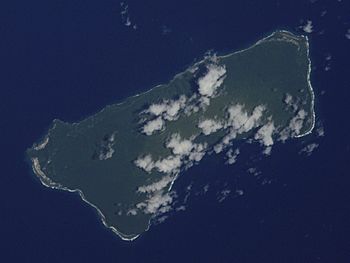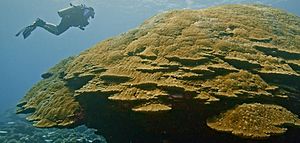Taʻū facts for kids

Ta'u as seen from space
|
|
| Geography | |
|---|---|
| Location | Southern Pacific Ocean |
| Coordinates | 14°14′S 169°28′W / 14.233°S 169.467°W |
| Area | 44.31 km2 (17.11 sq mi) |
| Highest elevation | 931 m (3,054 ft) |
| Highest point | Lata Mountain |
| Administration | |
|
United States
|
|
| Territory of the United States | American Samoa |
| Demographics | |
| Population | 790 (in 2010) |
Taʻū is the largest island in the Manuʻa Group and the easternmost volcanic island of the Samoan Islands. Taʻū is part of American Samoa. In the early 19th century, the island was sometimes called Opoun.
Taʻū is well known as the site where the American anthropologist Margaret Mead conducted her dissertation research in Samoa in the 1920s, after which she published her findings in a work titled Coming of Age in Samoa. Ta’u also has the highest mountain in American Samoa, Mount Lata, as well as 21 square kilometers (8.3 sq mi) of National Park lands, and 1.5 sq mi (3.9 km2) of waters separated by some of the tallest sea cliffs in the world.
On the western coast of Taʻū are the conterminous villages of Lumā and Siufaga, usually referred to jointly as Taʻū village. The village of Taʻū has been named the capital of the Manu'a Islands. Fitiuta is another Taʻū village, located on the northeast side of the island.
Geography
The island is the eroded remnant of a hotspot shield volcano with a caldera complex or collapse feature (Liu Bench) on the south face. The summit of the island, called Lata Mountain, is at an elevation of 931 m (3,054 ft), making it the highest point in American Samoa. The last known volcanic eruption in the Manuʻa Islands was in 1866, on the submarine ridge that extends west-northwest towards nearby Ofu-Olosega.
The largest airport in the Manuʻa Islands is on the northeast corner of Taʻū at Fitiʻuta. There is also a private airport. A boat harbor is located at Faleāsao at the northwestern corner of the island. A roadway along the north coast connects all of the several inhabited villages between Taʻū on the west and Fitiʻuta.
All of the southeastern half of Taʻū—including all of the rainforest on top of Lata Mountain and within the caldera—the southern shoreline, and associated coral reefs are part of the National Park of American Samoa. The park includes the ancient, sacred site of Saua, considered to be the birthplace of the Polynesian people.

Administratively, the island is divided into three counties: Faleasao County, Fitiuta County, and Ta'u County. Along with Ofu and Olosega islands, Taʻū Island comprises the Manua District of American Samoa. The land area of Taʻū Island is 44.31 km2 (17.11 sq mi) and it had a population of 873 persons as of the 2000 census and of 790 persons in the 2010 census.
In 2000, a subsea volcano 30 mi (48 km) from Taʻū Island was discovered by scientists. Rockne Volcano has formed an undersea mountain which is 14,000 ft (4,300 m) tall. Its peak is 18,000 ft (5,500 m) below the ocean surface.
Anthropological research
Taʻū is where the 23-year-old anthropologist Margaret Mead conducted her dissertation research in Samoa in the 1920s, published in 1928 as Coming of Age in Samoa. In her work, she studied adolescent teenage girls and compared their experience to those of Western societies. She concluded that adolescence was a smooth transition, not marked by the emotional or psychological distress, anxiety, or confusion seen in the United States.
Electricity
Until 2016, being a small and isolated island, the island relied on costly and polluting diesel generators to supply electricity. However, with the construction of a solar array, battery storage system, and microgrid, the island's power relies almost 100% from the sun. The solar array was built by SolarCity and now includes sixty Tesla Powerpacks. The system should be a more reliable source of energy and was designed to power the entire island for three days without sunlight and fully recharge in seven hours.
See also
 In Spanish: Ta'u para niños
In Spanish: Ta'u para niños

